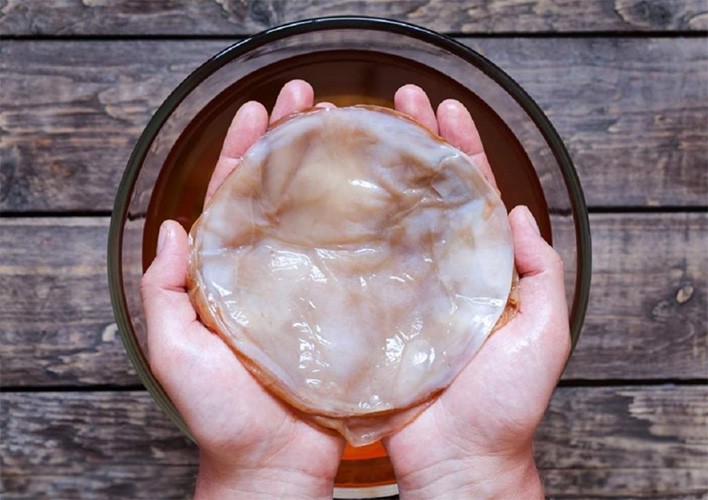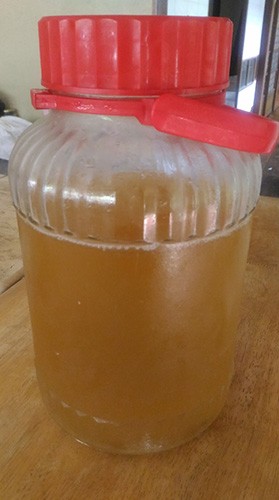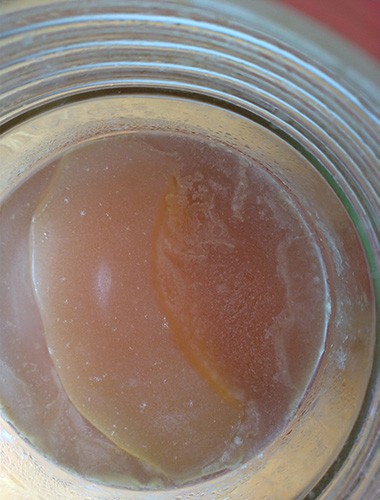Today I’m going to tell you all about how to make your own kombucha. Kombucha is a tangy and slightly fizzy drink. It is made from tea fermented with a mother strain called SCOBY. This is a combination of bacteria and yeast that interact together and cause a double fermentation. Rich in enzymes and probiotics, kombucha is excellent for digestion. Want to brew your own kombucha with love and patience? Let’s get started!
What is kombucha?
Name

The name kombucha pronounced “komboutcha” comes from the Japanese 昆布茶 kombu seaweed and (o)cha tea. However, this name is a mistake. In fact, Japanese kombucha is algae tea. Whereas kombucha drink, so called by confusion in Europe and the United States, is a drink made from fermented tea. In this article, I am talking about the drink made from a mother of kombucha ‘SCOBY’
Kombucha is known by many different names in the East. All of them mean “tea mushroom” because of the appearance of the SCOBY, which looks like a slimy mushroom. It is also called “Manchurian mushroom”, or “elixir of immortality”
SCOBY is an acronym meaning “symbiotic culture of bacteria and yeast”.
- Japanese 紅茶キノコ kōcha-kinoko, “red tea fungus”.
- Modern Chinese 红茶菌 hong cha jun “red tea microbe”, or traditionally shenxian cu (神仙 醋, “immortal vinegar”)
- Korean 홍차버섯차 hongcha-beoseot-cha, “red tea mushroom tea/tisane”,
- Russian Чайный гриб (chaynyy grib)
SCOBY is also named in Chinese 海 宝 haibao, “treasure of the sea.” Because its appearance reminds one of a jellyfish. Or 胃 宝 weibao, “stomach treasure” because it is said to cure stomach ache. Or 康普 茶 kangpucha in its anglicized name (only on the drink made from green tea)
Composition of Kombucha, a living drink
The culture used to make kombucha tea is based on different species of bacteria and yeast. That can varie from one culture to another. These bacteria and yeast grow in an acidic solution, forming a “zooglee mat” (biofilm) also called “mother” or SCOBY.
- Acetic bacteria: Acetobacter aceti subsp. aceti, Gluconobacter oxydans subsp. industrius, subsp. oxydans and Gluconoacetobacter xylinus (=Komagataeibacter xylinus)
- Other bacteria: Bacterium xylinum, Bacterium gluconicum, Bacterium xylinoides, Bacterium katogenum
- Yeasts: Saccharomycodes ludwigii, Schizosaccharomyces pombe, Lachancea , Saccharomycoides, Kluyveromyces, Brettanomyces bruxellensis, Pichia fermentans, Candida stellata, Candida, Kloeckera / Hanseniaspora, Torulaspora delbrueckii or Zygosaccharomyces bailii
The acidic solution contains
- Traces of alcohol
- Lactates
- Ethyl acetate
- Acetic acid, gluconic acid, lactic acid,
- Amino acids
- Antibiotic compounds
- Folic acid
- Enzymes
The chemical reaction
Yeast converts sugar into alcohol, which is why kombucha contains very little alcohol. Bacteria (especially Komagataeibacter xylinus) then convert the alcohol into acetic acid and other substances. This increases the acidity and limits the ethanol content. From this chemical reaction organic substances are produced which feed the symbiont.
The kombucha bacteria need large amounts of oxygen for their growth and activity. This is why a kombucha jar is never closed, but a light cloth is placed over it. The population of acetic acid producing bacteria and yeast would increase during the first 4 days of fermentation, and decrease thereafter.
In principle, it is the acidification of the solution that prevents undesirable moulds (fungi) and bacteria from taking hold. But this can happen for various reasons. However, don’t panic, I always save my SCOBYs: there are solutions that I will mention.
With fermentation, carbon dioxide is released which makes the drink slightly “fizzy“. It is even more fizzy when you add ginger (I love it!)
Apparently, the K. xylinus bacterium produces microbial cellulose. It would be responsible for most or all of the physical structure of the “mother”. It could possibly have been selected by brewers to have more danceable and therefore more resistant scoby cultures… Hence the fact that there are several types of kombucha mothers, with varying shapes and colours.
How to make your own kombucha?

To make kombucha, you need a SCOBY or Kombucha Mother. To get one, write me an email -> ask me HERE!
If I have any in stock, I will gladly prepare one for you and send it to you.
The kombucha mother takes the shape of a disc, the size of the container in which it is placed. The “discs” form gradually, one on top of the other. You can then separate them to obtain a new mother. But be patient, it takes time.
The tea to be consumed is obtained in 2 fermentations.
The first one with black or green tea, sugar, and a symbiosis of yeast and bacteria (scoby). Other strains will form on top of the culture during the fermentation.
Then the second fermentation takes place without the mother. Mostly with fruit to flavour it, according to taste.
First fermentation
Precaution of use
Wash your hands properly, with soap, and rinse the soap very well. Be careful, soap is basic, especially Marseille soap. But kombucha likes acid… Hence my warning. And don’t wipe with a cloth, as this could bring unwanted bacteria into the solution.
Tools and accessories must be clean and sterilised. No metal or plastic tools: kombucha does not like them at all! Prefer wooden tools.
As for the water for the tea: no hard water or chlorine, the SCOBY hates it. Favour spring water, mountain water… If you live in the city, this is not easy. So leave it in a carafe in the open air for a few hours. This will limit the presence of chlorine a little.
Otherwise, there are various solutions to purify your water. Such as charcoal, ceramic, sand and coral (okinawa technique)… And magnetising or doing reiki won’t do it any harm! If you want to learn REIKI, let me know! Take a look at Masaru Emoto‘s research on water. His son who took over his father’s research and company. I had the opportunity to meet him a few times in Tokyo.
Tools
- A large 4L or 5L glass jar, preferably with a tap for convenience.
- A plate
- A large saucepan
- A colander if you use bulk tea
- A small, light cloth and a rubber band
- A wooden spatula
Ingredients
- Your Kombucha strain (SCOBY) in its liquid.
- Vinegar
- Black or green tea (beware of flavoured teas: they are often chemically flavoured. SCOBY only likes natural and organic!
Procedure
- Wash your hands carefully
- Put 4L of water to rest in the open air for at least 1 hour (especially if it is tap water).
When it’s the first time, I rather put about 2 and a half litres at the beginning.
- Boil the water in the pan
- Let it cool down a bit to put the tea in. 10 teaspoons +/- according to your taste.
Tea does not like to be put in water at 100 degrees: let it cool down a bit. Let it steep according to your taste. It is better if it is concentrated to make kombucha.
- Strain the tea and let it cool down
Scoby does not tolerate temperatures above 27 degrees… Challenge in Japan in summer!
- Add 150g of sugar, preferably white.
Unfortunately, brown sugar is too rich in minerals and scoby does not like it. Be careful NEVER add HONEY!
- Add the solution that I sent you with the SCOBY, or the one you received. Or 10 tablespoons of cider vinegar for example.
Rice vinegar also works. If there are deposits, I would leave them for now. I only remove them afterwards. Because there are always some living bacteria or yeast that help to start the fermentation.
- Clean SCOBY san with vinegar, and massage it DELICATELY: it is a living organism!
Remove the “dead cells” which are easily loosened. They are dark brown, you can recognize them well.
- Place SCOBY delicately on the surface. Be careful, there is a direction: the top goes up, it is whiter in principle.
- Put a small cloth over the jar so that the preparation can breathe, with a rubber band.
This is mainly to prevent insects from getting in. Leave to ferment for 2 weeks, checking every day. Taste (with a clean, non-metallic ladle). If not sour enough, ferment more!
Did you leave it on for a long time?
Well done, you got kombucha vinegar! Great for cooking… but not really good for drinking. Just repeat the procedure with this very acidic base, making tea again.
I am not satisfied with the taste of my homemade kombucha…
Don’t panic, this is normal. Plain kombucha is special. It takes some getting used to before you become a fan.
And that’s where the second fermentation comes in to flavour it to your taste! You can also add sugar, but I don’t add it. As cancer and cholesterol problems are frequent, I prefer to limit the sugar intake. This allows me to share it more easily at organic markets, at our wellness retreats, and with the family. So, for the taste, I play mainly on the second fermentation of the fruits to flavour. Of course, this is still sugar, so I control the quantity.
Second fermentation
Take several 1L glass containers that can be closed. And fruits of your choice. My favourites:
- Ginger, yuzu
- Mint, lemon
- Apple, cinnamon
- Pomegranate
- Red fruits: raspberry, blackcurrant
The quantity is up to you. For my part, I put them in 1L containers. I cut small pieces. Then I put them inside so that they cover the bottom. At first, it stays on the surface. Then I close the container and let it ferment outside for a week or two.
Not in the fridge: the cold will stop the fermentation. Unless that’s what you want to do and preserve your homemade kombucha.
I like to add herbal teas like hibiscus (called carcadet in Egypt). Or herbs depending on the desired effect. But as I am also an herbalist, I know the plants well, especially European ones. And some “kanpo” from Japan, which I am still learning little by little. If you are not sure, don’t go in blind and stay on the fruit fermentation above. This is usually what is done.
In fact, I consume it whenever I want. And I add some of the solution the scoby is in regularly. And when the level gets lower, I make more tea for the scoby. As for the fruit, I also change it every month (I like it when it’s well fermented, it’s a question of taste).
I never wait until the level is too low for the solution where the scoby is. I never wait until the level is too low for the solution where the scoby is, because the scoby should always be left with 3-4 L of tea.
How do I get my scoby back if it has mould?

Sometimes kombucha is contaminated with mould or fungus. In this case, you should:
Cleaning
- Wash your hands carefully
- Separate the SCOCBY – kombucha mother.
- Clean it from dead cells and massage it with vinegar: make sure to remove all traces of mould.
- Put vinegar in a clean plate
- Place your kombucha mother in the dish, cover it, and leave it for a week or two
- Monitor it every day. Massage it with vinegar if you see the mould coming back. And change the vinegar base if necessary.
- And this until it becomes healthy again: it will gradually become white / transparent again.
Making homemade kombucha again
- Clean the kombucha container with boiling water
- Sterilize the container (20min in a pot of boiling water), let it cool
- Make some tea, filter, and pour it into the hot container (not 4L this time, start again with just 1L)
- Wait for it to cool down, to put the Kombucha SCOBY in it
After 10 days, no moisture? your kombucha is floating on the surface? OR it has sunk but is white, smooth, uniform? Add 3L of tea (to reach4L in total)
Here we go again! Patience, patience…
What are the benefits of Kombucha
The benefits of homemade kombucha are said to be numerous. You can also choose what you put in your second fermentation. Depending on your taste but also depending on the properties you want.
Many people find that their digestion improves when consuming kombucha. Such as reduced bloating after eating (small intestine), and better bowel movements (colon). This drink is also known to contribute to the decrease in bad LDL cholesterol and the increase in good HDL cholesterol. Of course, all this has to be verified by cross-referencing sources and studies. Ideally carried out by several laboratories and on several people…
I remain cautious about everything I share here. It’s up to you to do your research, everyone is responsible 🙂 If you have fragile intestines, irritable bowels, or other digestive problems, this may be something to try? In small quantities to observe your body. And I encourage you to learn about the functioning of all living organisms to better understand your body.
Why do we often read that kombucha is good for bowel movements?
As explained earlier, homemade kombucha contains probiotics that are said to help improve your gut flora. It is a so-called anti-oxidant, anti-microbial, and diuretic drink that would potentially be the reason why digestion would be aided.
In another article, I’ll look more into this aspect to tell you about it, and really know from a biological point of view why. Because when I read about benefits on magazines I always think “fine, but why?”. But for that, I have to ask my biologist friends. I have less lab time than them, although biology and biochemistry were an important part of my studies. Give me some time: I need to get the 3D diagram in my head before I can explain it to you (welcome to my tree-like complex brain!).
Don’t jump to conclusions…
The idea is not to reason “treatment of symptoms” but rather “treatment of the cause”… by having a more global understanding of the living. If you think you can solve your digestion problems by giving probiotics and bacteria to your body without looking further, it is a delusion. Maybe you will see temporary improvements… but that is not my approach. Because you still need to know the original cause of your digestive problems.
You can make an appointment in kinesiology or in shiatsu, we can look at that. I’ll do what’s in my domain, and redirect you for the rest if I suspect something.
<I’ll do what I have to do, and redirect you to the rest if I suspect anything.
Before I draw any conclusions, let me remind you that a digestive problem has a cause. And that very often it is related to an over-adaptability of your body, ultimately creating internal dysfunction. This is why, before treating a cause by trying to remove a symptom it is important to look at the body with a broader perspective…
It’s simple, everything that happens inside us is no different from what happens in all of life. You naturally have bacteria, yeast and fungi in your body. And when they “consume” food, well, like you, they make “organic waste“. In principle, the amount of waste is manageable, and eliminated by the body. But when your body is in a state of exhaustion (chronic stress being one of the primary causes), there can be an overabundance of these bacteria etc, too much waste, a difficulty for the body to adapt… Another factor is an overload of cortisol (stress hormone) which would also cause various dysfunctions. I won’t go into that today (I talk about it in one of my youtube videos).
And as a result, it’s good to find why the body is in a state of exhaustion and over-adaptation. It must be said that we abuse this body, with unsuitable life rhythms. Or ink a diet not always adapted, and an ingestion in non-optimal conditions.
How much can you drink?
It is not recommended to drink more than 2 glasses a day of kombucha. You can try to drink more in exceptional cases, but you risk going to the toilet! Sometimes it makes you feel good to drain and empty your bowels a bit. Followed by a young person, your organism will restore itself to health. The body is intelligent, it balances itself. But don’t overdo it, moderation is always a must. It is not a question of tiring the body.
Good to know…
Many kombucha sold in shops have been pasteurised. That is to say, heated to a high temperature to kill all living particles… In other words, since kombucha is made up of “living” elements, you have lost all the bacteria that are actually good for your health. Too bad! So it’s a flavoured tea-like drink, but it’s not “kombucha”.
Where to get it?
-You live in Japan? > CLICK ABOVE <
-> CONTACT-ME if you live in other country, it’s totally possible!
-> No more SCOBY available? Contact me to place your pre order for your Kombucha starter kit. As soon as it’s ready, receive it at home!
NOTE: I’m doing a small production with lots of love and care… and I avoid plastic as much as possible.
Did you learn anything from this article?
Share it on social networks or around you!
Don’t hesitate to ask me for a KOMBUCHA mother, share your tests in comments, or ask me your questions by email

